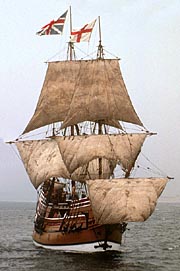

 |
The new Pilgrims will sail in a Mayflower replica soon to be built. Pictured: Mayflower II, an earlier clone now docked at Plymouth, Mass. |
Reality series to be edited at sea as new Mayflower sails Atlantic
Nearly four centuries after the Pilgrims crossed the Atlantic in search of economic fortune and religious freedom, public TV will follow a replica of the Mayflower tracing their path to the New World.
Budgeted at more than $10 million, Mayflower seeks to re-create the voyage that began in Plymouth, England, in 1620 and ended almost two months later in what became Plymouth, Mass. The six-hour living-history project is a collaboration of WGBH's science unit, Britain’s Channel Four and Independent Television News.
To get the six-hour series on the air by Thanksgiving 2005, the crew will edit tape in postproduction suites aboard an accompanying ship during the fall’s five-week crossing. Timing is tight, and production crews will begin work at sea to ready the project for air, says Jonathan Renes, a senior publicist for WGBH. Producers on the “chase ship” will also operate remote-control cameras on the Mayflower.
Producers will select about 30 British and American volunteers in addition to the ship’s crew to participate in the project, says Paula Apsell, executive producer. Two or three camera operators will also live among the Pilgrims. The cast will be expected to imitate 17th-century dress, diet, work and play. “The point is to see how modern people do with the privations the settlers faced,” Apsell says.
The cast will be chosen in spring 2005 and undergo training and trials that summer. For safety reasons, producers will exclude small children from participating in the documentary — although kids were part of the original Mayflower journey and three infants were born during the trip.
The first hour of the documentary will focus on the building of the Mayflower replica in England. Construction has begun and will wrap some time next year — how soon depends on cash flow, she adds. The remaining five hours of the doc will focus on the trip across the Atlantic.
Safety of the passengers and the crew will be the project’s top priority, Apsell says. Though sickness was rife aboard the original Mayflower ship, remarkably, only one person died. The chase ship will be equipped with medical personnel and an onboard hospital, Apsell reports.
The original Mayflower was not a comfortable ship, she says. It was a merchant vessel — designed to transport cargo, not people. Its 132 passengers were crammed into tight quarters and slept on hammocks rigged below deck. During stormy weather, they were forbidden from coming on deck.
Thanks to international law and insurance regulations, the modern-day passengers will have contemporary bathrooms and showers. But even with some modern amenities, this will be a dangerous and challenging journey, Apsell says. The cast will cook their own food, perform daily tasks and help the crew operate the ship.
Apsell expects Mayflower to draw enormous attention. Not since the 1950s has anyone tried to build a replica of the ship and sail it across the Atlantic. The Mayflower of that journey—Mayflower II—is now docked in a Massachusetts museum and occasionally makes trips to Boston, Renes says, but making it seaworthy would have cost more than building a new ship.
Mayflower needs to cut and share costs where it can. The producers tapped Nova for part of the budget — the first hour on construction of the ship will air on the series.
The educational value outweighs the difficulties, Apsell says. Students will be able to follow the ship’s progress via the Mayflower website. They can also read up on the Mayflower Compact, a document written and signed by the settlers that established the first self-government in the New World. This is a history, science and civics lesson all rolled into one, she says: “In terms of educational opportunities, this is just fantastic.”
Posted Nov. 12, 2003
Current: the newspaper about public TV and radio in the United States
Current Publishing Committee, Takoma Park, Md.
(301) 270-7240